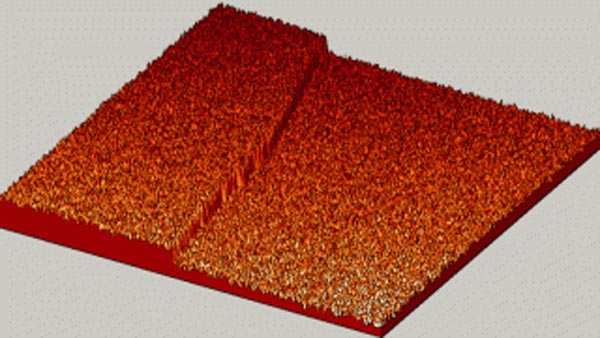“Explosive” Atom Movement Is New Window Into Growing Metal Nanostructures

U.S. Dept. of Energy's Ames Laboratory Ames Laboratory scientists observed lead atoms unexpectedly moving collectively on a lead-on-silicon surface to "explosively" form metal nanostructures, all at low temperatures. The area shown here is about one-twentieth of the width of a human hair.
Tringides is talking about the unusual atom movement he saw when they dropped a few thousand lead atoms onto a flat, smooth lead-on-silicon surface, all at low temperatures, and looked at an area just one-twentieth the width of a human hair.
What the Ames Laboratory scientists expected to see was “random-walk diffusion”: atoms milling around, looking like they have no idea where they’re going, where they’ve been, or that any fellow atoms are near them. Typically, the atoms eventually happen to run into each other and create small structures.
“Instead, we saw atoms that are very focused and work together well to quickly create tiny lead nanostructures,” said Tringides. “That kind of ‘collective diffusion,’ is really the exception to the rule in atom movement. Plus, we were surprised by how fast well-organized crystal structures nucleate at such cold temperatures, where movement is typically slow.”
The collective, fast diffusion observed by Tringides’ team could represent a new way to grow perfect, tiny metal nanostructures.
“If we’re able to make a nanoscale lead object this fast, we can perhaps create other objects this way.” said Tringides. “Understanding the basic science of how materials work at these nanoscales may be key to making nanotransistors, nanoswitches and nanomagnets smaller, faster and reliably.”
Tringides’ research team specializes in measuring how atoms move on surfaces, revealing through scanning tunneling microscopy how the smallest structures begin to form. Over the past several years, they’ve used their expertise to answer fundamental questions about materials, such as rare-earths, graphene and metallic films, that are important to green energy technologies.
This research, which appeared in Physical Review Letters, is supported by the U.S. Department of Energy Office of Science.
Ames Laboratory is a U.S. Department of Energy Office of Science national laboratory operated by Iowa State University. Ames Laboratory creates innovative materials, technologies and energy solutions. We use our expertise, unique capabilities and interdisciplinary collaborations to solve global problems.
DOE’s Office of Science is the single largest supporter of basic research in the physical sciences in the United States, and is working to address some of the most pressing challenges of our time. For more information, please visit science.energy.gov
Contact Information
Breehan Gerleman Lucchesi
Communications specialist
breehan@ameslab.gov
Phone: 515-294-9750
Media Contact
More Information:
http://www.ameslab.govAll latest news from the category: Materials Sciences
Materials management deals with the research, development, manufacturing and processing of raw and industrial materials. Key aspects here are biological and medical issues, which play an increasingly important role in this field.
innovations-report offers in-depth articles related to the development and application of materials and the structure and properties of new materials.
Newest articles

First-of-its-kind study uses remote sensing to monitor plastic debris in rivers and lakes
Remote sensing creates a cost-effective solution to monitoring plastic pollution. A first-of-its-kind study from researchers at the University of Minnesota Twin Cities shows how remote sensing can help monitor and…

Laser-based artificial neuron mimics nerve cell functions at lightning speed
With a processing speed a billion times faster than nature, chip-based laser neuron could help advance AI tasks such as pattern recognition and sequence prediction. Researchers have developed a laser-based…

Optimising the processing of plastic waste
Just one look in the yellow bin reveals a colourful jumble of different types of plastic. However, the purer and more uniform plastic waste is, the easier it is to…



